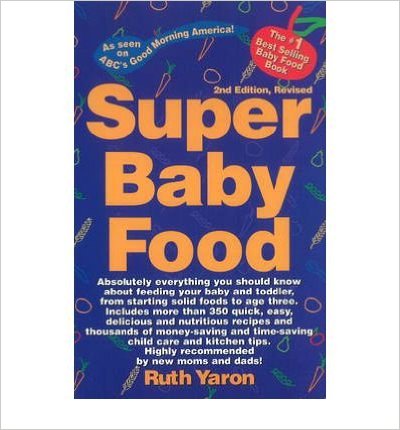Baby’s First Solid Foods and Beyond
- What: Super Baby Food book by Ruth Yaron
- When: Six months to three years
- Why: Great guide for what foods to introduce and when, tons of helpful hints
- Where: Amazon
Thinking about making your own baby food? You go girl! I am all in favor, though I freely admit that I started my baby food making adventure before the advent of baby food pouches, which are basically God’s gift to moms on the go.
Making your own baby food isn’t as hard as you might think. My culinary skills extend to boiling water, and that’s pretty much the only skill required to make baby food. If you can make mush, you are good to go.
Better news: pediatricians these days don’t recommend starting solids until age four months or even as late as six months in most cases. Unlike me, who got force fed (did I say force fed? I meant spoon fed with lots of love!) commercial baby cereal at age six weeks in hopes I would sleep through the night. I don’t hold a grudge, though possibly that’s because I can’t remember.
If you’re going to try making baby food, make an investment in Super Baby Food. As far as I’m concerned, it is the homemade baby and toddler food bible. It even comes in a Kindle format now.
Did I do everything in there? Not by a long shot. Did my kids avoid almost every cold, ear infection, and other illness going around? Yup. That’s probably got to do more with luck or my paranoid sanitizing obsession, but it can’t have hurt, either.
Super Baby Food Book on Amazon
We started with avocado, which doesn’t even require boiling water. Nor will you find avocado as an ingredient in any commercial baby food I’ve seen. But the healthy fats and smooth texture go a long way as a great first food. We went with banana next, which also requires a fork and some mushing to get it to the correct consistency. After that, I went with the homemade cereal route, which did cause me to muster all my culinary skills – boiling water and stirring. But anyone could easily start with one or two items and save themselves boatloads of money and trips to the store. Go ahead. Read the label on a baby food jar next time one is handy. The most common ingredient? Water. Unless you’re buying bottled water by the flat, you have that at home for free (well, you are already paying for it unless you are awesome and have your own well, in which case you’ve already paid for it). I loved knowing what went into my baby’s mouth and I’m not up to date on my weird preservative terms, nor did I have the brainpower to decipher anything else on the label.
But even if you’re not manufacturing any baby food, check out Super Baby Food from your local library and give it a look. It boasts oodles of helpful hints, like pushing baby’s sleeves up before feeding him to simplify clean up. And it has tons of snack ideas for toddlers and babies alike, as well as a helpful advice regarding everything from childcare to kitchen care.







Leave a Reply